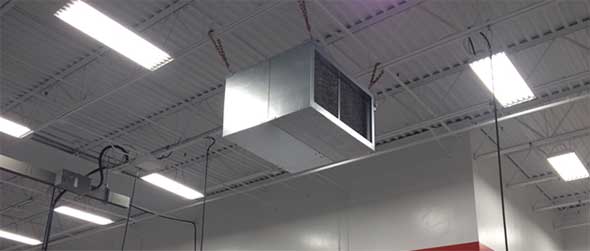Isolation, Source, And Ambient Capture
February 7th, 2018 | Posted in Air Cleaners
A common question comes up very frequently, and that is “how do you determine if you should do source capture or ambient capture?” Well, the simple answer is you should do source capture; however it is not always convenient or possible to do source capture. What I am going to talk about is the pros and cons of doing isolation, source, and ambient capture. Yes, I just threw isolation capture in there. A lot of times we treat source and isolation capture the same because you are capturing the contaminant at the source.
1. Isolation Capture
The first thing I am going to talk about is the best solution of the three, and that is isolation capture. If you look at the image below you can see a MistBuster® connected to a machine tool enclosure. What we are accomplishing here is preventing the coolant mist from escaping the machine tool enclosure by putting the enclosure under negative pressure by using the MistBuster®. The MistBuster® filters the exhausted air so it can be returned into the shop. Isolation capture can be accomplished in many applications where you are trying to contain the contaminant you are generating. The reason this is the best option is that you are dealing with the contaminant right at the source before anyone can breathe it in and before it spreads in the room. Also, with smaller enclosures or rooms that are well enclosed, you will not need a lot of CFM to keep the contaminant inside the enclosure. A proper enclosure is one that has very few to no open area between the room you are trying to keep clean and the enclosure you are generating the contaminant. The primary issue that can arise with isolation capture is it can impede the progress of production work because it can get in the way of equipment you use to handle your product or during fabrication the fabricator needs to handle the part.
2. Source Capture
The second capture method I am going to talk about is source capture. Source capture is where you are using a hood to capture the contaminant being generated as you can see in the images below. Source capture has the same benefit as isolation capture because you are capturing right at the source. The drawbacks of source capture are if the contaminant is not readily rising into the hood the hood will need to be placed close to the source of the contaminant and if the source of the contaminant moves the hood will need to be moved as well. If the hood is not kept in close proximity or the hood is not big enough some of the contaminants will bypass the hood and go into the room. If a larger hood is needed you will need more airflow which means you will need a bigger air cleaner.
3. Ambient Capture
The third capture method and not the best capture method is ambient capture. The big reason ambient capture is the third is because the contaminant needs to make its way to the air cleaner to remove it from the area, which means you could breathe the contaminant in before it is captured. This is why we do not recommend or advise using ambient filtration for more hazardous contaminants like hexavalent chromium that comes from stainless welding. Also, very large rooms or shops can require several air cleaners which can be costly. The big benefit of ambient filtration is when the air cleaners are on they are constantly cleaning the air to help keep the amount of contaminant down in the room or shop.
The Ultimate Capture Method
Now you are probably confused or wondering what else I can throw at you since I talked about the three major methods of capturing contaminant. Well in a way you are right in a way, the ultimate solution for dealing with contaminant is to use a combination of all three. What this means is in a large shop where you are doing many things it is important to isolate things where you can, capture things where you can’t isolate, and then to ensure you are keeping the air as clean as possible use ambient filtration to clean the room or shop to ensure anything that was missed will be captured. If you look at the table below you can see the pros and cons of the three capture methods and by using a combinations of the three you can deal with your contaminant issues. Not all customers go to the ultimate method of capturing and give us a call at Air Quality Engineering to talk with an air cleaner specialist to see what we can do for you.
| Pros | Cons | |
| Isolation Capture | – Keeps contaminant contained within enclosure. – Typically will require less CFM than source capture and ambient capture. |
– Requires an enclosure or room that could impede production. |
| Source Capture | – Captures contaminant right at the source. – Works well when contaminant readily rises into the hood. – Works well when the point of generation does not move. |
– Larger source capture hoods require more CFM. – Hood will need to be placed relatively close to where the contaminant is being generated. |
| Ambient Capture | – Airborne contaminant will eventually be captured. – Does not require ductwork. – When units are functioning they are always capturing contaminant. |
– Contaminant is floating around workers before it is captured. – Some of the contaminants will settle in the room before it is captured. – Larger areas require more CFM. – Not recommended for more hazardous applications. |




